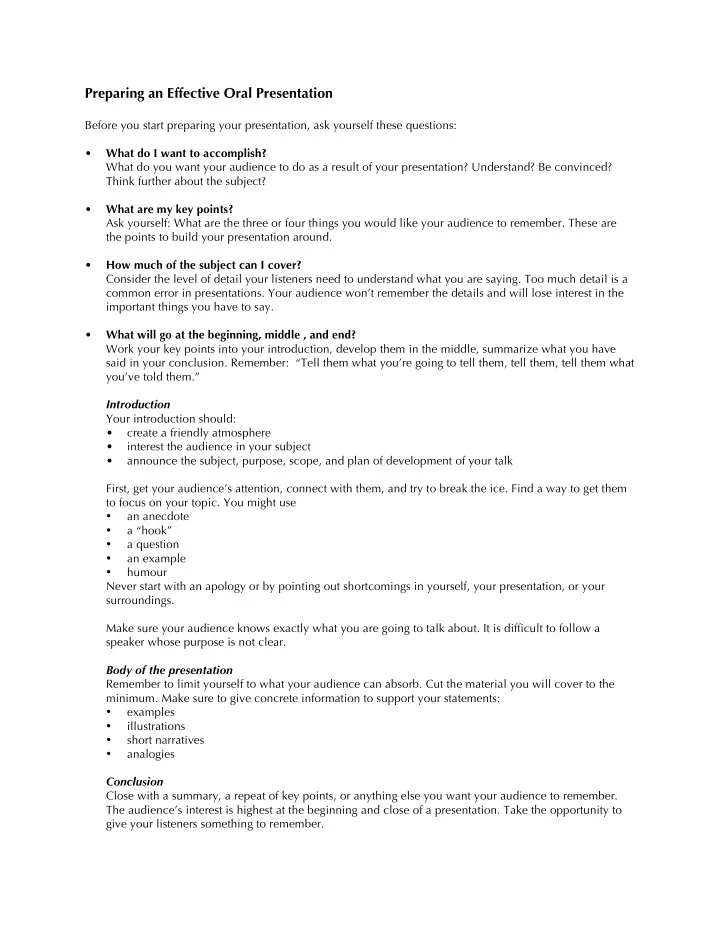

Preparing an Effective Oral Presentation Before you start preparing your presentation, ask yourself these questions: • What do I want to accomplish? What do you want your audience to do as a result of your presentation? Understand? Be convinced? Think further about the subject? • What are my key points? Ask yourself: What are the three or four things you would like your audience to remember. These are the points to build your presentation around. • How much of the subject can I cover? Consider the level of detail your listeners need to understand what you are saying. Too much detail is a common error in presentations. Your audience won’t remember the details and will lose interest in the important things you have to say. • What will go at the beginning, middle , and end? Work your key points into your introduction, develop them in the middle, summarize what you have said in your conclusion. Remember: “Tell them what you’re going to tell them, tell them, tell them what you’ve told them.” Introduction Your introduction should: • create a friendly atmosphere • interest the audience in your subject • announce the subject, purpose, scope, and plan of development of your talk First, get your audience’s attention, connect with them, and try to break the ice. Find a way to get them to focus on your topic. You might use • an anecdote • a “hook” • a question • an example • humour Never start with an apology or by pointing out shortcomings in yourself, your presentation, or your surroundings. Make sure your audience knows exactly what you are going to talk about. It is difficult to follow a speaker whose purpose is not clear. Body of the presentation Remember to limit yourself to what your audience can absorb. Cut the material you will cover to the minimum. Make sure to give concrete information to support your statements: • examples • illustrations • short narratives • analogies Conclusion Close with a summary, a repeat of key points, or anything else you want your audience to remember. The audience’s interest is highest at the beginning and close of a presentation. Take the opportunity to give your listeners something to remember.
Some Tips for Preparing an Oral Presentation • Develop a positive, keen attitude towards your presentation. How you feel about speaking has a great influence on how your audience responds. It’s normal to be nervous, but if you act as if you’re performing a really unpleasant task, your audience is likely to feel the same way about listening. • Refine your outline until you know exactly how you will deliver each part of your presentation. • Design legible and simple visual aids. See the handout on PowerPoint presentations for more tips. • Rehearse! It’s hard to overemphasize the importance of rehearsing your talk, both to improve its quality and to give you confidence. Rehearse aloud—try out your presentation for time and clarity. Then rehearse some more. Remember the time limit. Some Tips For Delivering An Oral Presentation • Try to relax. Use whatever technique you can to help yourself stay calm and in control. • Connect with your audience. You are not speaking to the walls; you are trying to communicate with the people in the room. Smile and be friendly; your audience will reciprocate. • Where it works with your material, try to present information in chunks of three so that your audience can see a pattern in them. • Use verbal signposts to orient your audience–that is, links and arrows. They will show the transitions between topics ( first, second, next or therefore, however, at this point, etc .) . • Keep your choice of words simple—if you have to use a technical term, explain it briefly. • Conclude rather than merely stop talking. That is, leave your audience with a clear sense of where they’ve been. • Look at your audience rather than the screen, the furniture, or even one particular individual. Eye contact establishes a personal link between you and your audience. It also helps you keep track of your audience’s reaction. • Don’t read your report—talk it. Don’t memorize and recite whole sentences and paragraphs. • Be audible and understandable—make sure people all over the room can hear you. Vary the pitch of your voice. Watch the ums and other verbal ticks (like you know or the giggles). • Be professional in appearance and manner. • Assume a natural posture. Don’t be afraid to use your hands to underline a point. • Don’t be afraid to move—be animated (although don’t overdo it). Movement puts nervous energy to work, keeps the audience’s attention on you, and makes you feel more confident.
Tips for the Very Nervous • Test your fears against reality. What is the worst that could happen? • Reassure yourself. Be positive about the presentation, and fight against negative thoughts. • Rehearse until you know your material “cold.” • Watch your body language. If you appear self-assured, it won’t matter if you’re not. Be conscious of your body without being self-conscious. Think about the way you stand, hold your head, breathe. Most of all, relax. • Ask for feedback. Ask someone you trust to listen to you and critique your presentation. Many of the things you worry about will be invisible to your audience. Your shaking knees may unsettle you; most likely your audience won’t even notice.
Recommend
More recommend